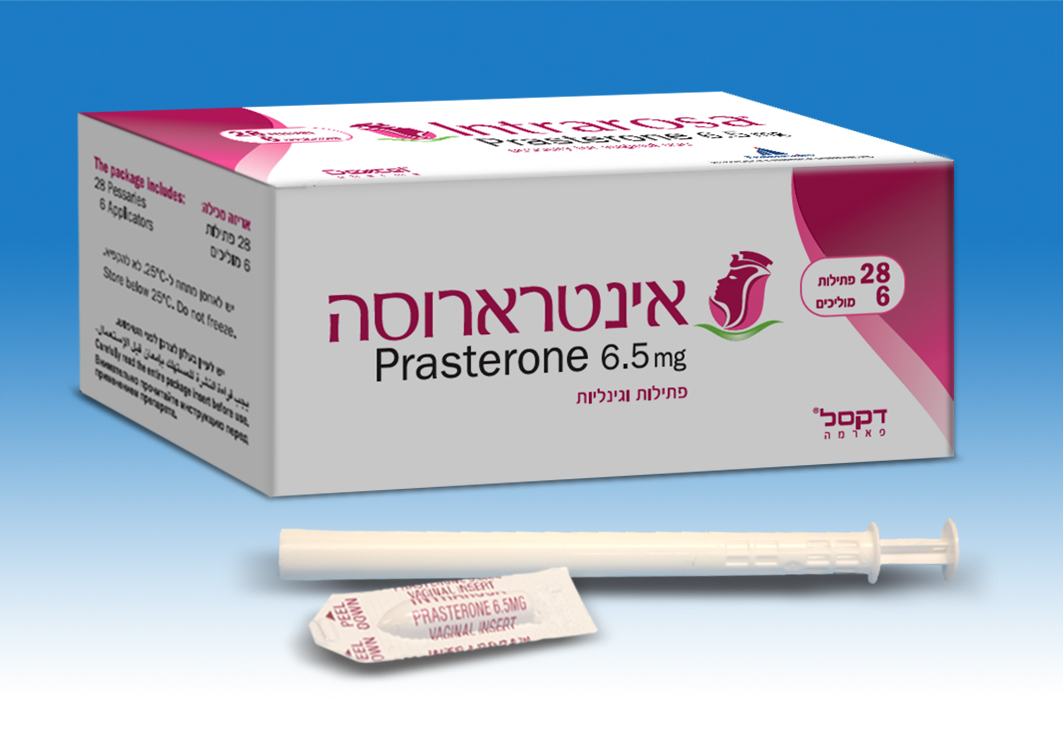Quest for the right Drug

אינטרארוסה INTRAROSA (PRASTERONE)
תרופה במרשם
תרופה בסל
נרקוטיקה
ציטוטוקסיקה
צורת מתן:
תוך-וגינלי : INTRAVAGINAL
צורת מינון:
אין פרטים : VAGINAL PESSARIES
עלון לרופא
מינוניםPosology התוויות
Indications תופעות לוואי
Adverse reactions התוויות נגד
Contraindications אינטראקציות
Interactions מינון יתר
Overdose הריון/הנקה
Pregnancy & Lactation אוכלוסיות מיוחדות
Special populations תכונות פרמקולוגיות
Pharmacological properties מידע רוקחי
Pharmaceutical particulars אזהרת שימוש
Special Warning עלון לרופא
Physicians Leaflet
Adverse reactions : תופעות לוואי
4.8 Undesirable effects Summary of safety profile The most frequently observed adverse reaction was vaginal discharge. This is due to melting of the hard fat used as vehicle, added to the expected increase in vaginal secretions due to treatment. It is not required to stop Intrarosa if vaginal discharge occurs (see section 4.4). Tabulated list of adverse reactions Adverse reactions observed with prasterone 6.5 mg pessaries obtained from clinical studies are tabulated in Table 1 below. Table 1: Adverse reactions observed with prasterone 6.5 mg pessaries in clinical studies MedDRA System Organ Class Common Uncommon (≥ 1/100 to < 1/10) (≥ 1/1,000 to < 1/100) General disorders and Application site discharge - administration site conditions Reproductive system and Abnormal Pap smear (mostly Cervical/ uterine polyps breast disorders ASCUS or LGSIL) Breast mass (benign) Investigations Weight fluctuation - Breast cancer risk • An up to 2-fold increased risk of having breast cancer diagnosed is reported in women taking combined oestrogen-progestagen therapy for more than 5 years. • Any increased risk in users of oestrogen-only therapy is substantially lower than that seen in users of oestrogen-progestagen combinations. • The level of risk is dependent on the duration of use (see section 4.4). • Results of the largest randomised placebo-controlled study (WHI-study) and largest epidemiological study (MWS) are presented. Million Women study– Estimated additional risk of breast cancer after 5 years’ use Age Additional cases per 1000 never- Risk ratio & Additional cases per 1000 1 range users of HRT over a 5-year period 95%CI# HRT users over 5 years (years) (95%CI) Oestrogen only HRT 50-65 9-12 1.2 1-2 (0-3) #Overall risk ratio. The risk ratio is not constant but will increase with increasing duration on use 1 *Taken from baseline incidence rates in developed countries US WHI studies - additional risk of breast cancer after 5 years’ use Age Incidence per 1000 women in Risk ratio & Additional cases per 1000 range placebo arm over 5 years 95%CI HRT users over 5 years (years) (95%CI) CEE oestrogen-only 50-79 21 0.8 (0.7 – 1.0) -4 (-6 – 0)*2 Ovarian cancer Use of oestrogen-only or combined oestrogen-progestagen HRT has been associated with a slightly increased risk of having ovarian cancer diagnosed (see section 4.4). A meta-analysis from 52 epidemiological studies reported an increased risk of ovarian cancer in women currently using HRT compared to women who have never used HRT (RR 1.43, 95% CI 1.31- 1.56). For women aged 50 to 54 years taking 5 years of HRT, this results in about 1 extra case per 2000 users. In women aged 50 to 54 who are not taking HRT, about 2 women in 2000 will be diagnosed with ovarian cancer over a 5-year period. Risk of venous thromboembolism HRT is associated with a 1.3-3-fold increased relative risk of developing VTE, i.e. deep vein thrombosis or pulmonary embolism. The occurrence of such an event is more likely in the first year of using HT (see section 4.4). Results of the WHI studies are presented: WHI Studies - Additional risk of VTE over 5 years’ use Age range Incidence per 1000 women in Risk ratio and Additional cases per 1000 (years) placebo arm over 5 years 95%CI HRT users Oral oestrogen-only*3 50-59 7 1.2 (0.6 - 2.4) 1 (-3 – 10) Risk of coronary artery disease • The risk of coronary artery disease is slightly increased in users of combined oestrogen-progestagen HRT over the age of 60 (see section 4.4). Risk of ischaemic stroke • The use of oestrogen-only and oestrogen + progestagen therapy is associated with an up to 1.5 fold increased relative risk of ischaemic stroke. The risk of haemorrhagic stroke is not increased during use of HRT. • This relative risk is not dependent on age or on duration of use, but as the baseline risk is strongly age-dependent, the overall risk of stroke in women who use HRT will increase with age, see section 4.4. WHI studies combined - Additional risk of ischaemic stroke*4 over 5 years’ use Age range Incidence per 1000 women in Risk ratio and Additional cases per 1000 (years) placebo arm over 5 years 95%CI HRT users over 5 years 50-59 8 1.3 (1.1-1.6) 3 (1-5) Other adverse reactions have been reported in association with oestrogen/progestagen treatment: – Gall bladder disease. 2 *WHI study in women with no uterus, which did not show an increase in risk of breast cancer 3 *Study in women with no uterus 4 *no differentiation was made between ischaemic and haemorrhagic stroke – Skin and subcutaneous disorders: chloasma, erythema multiforme, erythema nodosum, vascular purpura. – Probable dementia over the age of 65 (see section 4.4). Reporting of suspected adverse reactions Reporting suspected adverse reactions after authorisation of the medicinal product is important. It allows continued monitoring of the benefit/risk balance of the medicinal product. Any suspected adverse events should be reported to the Ministry of Health according to the National Regulation by using an online form: https://sideeffects.health.gov.il

שימוש לפי פנקס קופ''ח כללית 1994
לא צוין
תאריך הכללה מקורי בסל
לא צוין
הגבלות
לא צוין
מידע נוסף
